- Art Home
- Exhibitions
-
Explore the Collection
- Explore the Collection Home
- African Art
- American Paintings, Sculpture and Drawings
- Contemporary
- Decorative Arts and Design
- East Asian Art
- European Paintings, Sculpture and Drawings
- Fashion Arts and Textiles
- Musical Instruments
- Indigenous American Art
- Photography
- Prints
- South Asian Art, Islamic Art and Antiquities
- Conservation
- Meet the Curators
- Digital Resources
- Events & Programs Home
- Calendar
- Accessibility
- Adults
-
Families & Teens
- Families & Teens Home
- 10x10 Teen Art Expo
- Art on the Rise
- Art Together: Art Making for Families with Children Ages 3–5
- Baby Tours
- Boy Scouts / Girl Scouts
- CAM Kids Day
- Choose Your Own Gallery Adventure
- Family Storytime and Gallery Walk
- Family Studio: Art Making for Families with Children Ages 6–12
- REC Reads
- Rosenthal Education Center (REC)
- See Play Learn Kits
- Summer Camp
- Teachers
- Community Outreach
- Fundraisers
- Plan Your Own Event

- Art Home
- Exhibitions
-
Explore the Collection
- Explore the Collection Home
- African Art
- American Paintings, Sculpture and Drawings
- Contemporary
- Decorative Arts and Design
- East Asian Art
- European Paintings, Sculpture and Drawings
- Fashion Arts and Textiles
- Musical Instruments
- Indigenous American Art
- Photography
- Prints
- South Asian Art, Islamic Art and Antiquities
- Conservation
- Meet the Curators
- Digital Resources
- Events & Programs Home
- Calendar
- Accessibility
- Adults
-
Families & Teens
- Families & Teens Home
- 10x10 Teen Art Expo
- Art on the Rise
- Art Together: Art Making for Families with Children Ages 3–5
- Baby Tours
- Boy Scouts / Girl Scouts
- CAM Kids Day
- Choose Your Own Gallery Adventure
- Family Storytime and Gallery Walk
- Family Studio: Art Making for Families with Children Ages 6–12
- REC Reads
- Rosenthal Education Center (REC)
- See Play Learn Kits
- Summer Camp
- Teachers
- Community Outreach
- Fundraisers
- Plan Your Own Event
Blog
Blog
- Home
- Plan Your Visit
-
Art
- Art Home
- Exhibitions
-
Explore the Collection
- Explore the Collection Home
- African Art
- American Paintings, Sculpture and Drawings
- Contemporary
- Decorative Arts and Design
- East Asian Art
- European Paintings, Sculpture and Drawings
- Fashion Arts and Textiles
- Musical Instruments
- Indigenous American Art
- Photography
- Prints
- South Asian Art, Islamic Art and Antiquities
- Conservation
- Meet the Curators
- Digital Resources
-
Events & Programs
- Events & Programs Home
- Calendar
- Accessibility
- Adults
-
Families & Teens
- Families & Teens Home
- 10x10 Teen Art Expo
- Art on the Rise
- Art Together: Art Making for Families with Children Ages 3–5
- Baby Tours
- Boy Scouts / Girl Scouts
- CAM Kids Day
- Choose Your Own Gallery Adventure
- Family Storytime and Gallery Walk
- Family Studio: Art Making for Families with Children Ages 6–12
- REC Reads
- Rosenthal Education Center (REC)
- See Play Learn Kits
- Summer Camp
- Teachers
- Community Outreach
- Fundraisers
- Plan Your Own Event
- Give & Join
- About
- Tickets
- Calendar
- Exhibitions
- Blog
- Shop
Behind the Scenes in Exhibition Design: Rudi Gernreich’s “Total Look”
by Chrystal Roggenkamp
3/25/2015
exhibition design , design and installation , The Total Look , exhibitions , Fashion Arts & Textiles , Chrystal Roggenkamp , behind the scenes
As an art exhibition designer, I strive to create a dynamic experience for museum visitors that enhances the artwork without competing with it. This aesthetic balance, when paired with numerous technical and logistical challenges, calls for clever solutions no matter how simple the end result may seem at-a-glance. Luckily, here at the Cincinnati Art Museum, we have a great team of designers, carpenters, and art handlers who all come together to make the curator’s vision a reality.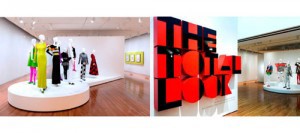
The design for The Total Look, an exhibition featuring the work of fashion designer Rudi Gernreich, revolves around a collection of over 60 garments full of vibrant psychedelic colors and geometric patterns. While the curators and I typically establish the color palettes for exhibitions, the scheme for The Total Look was actually developed by Peggy Moffitt, Rudi’s very own model/muse and the owner of the garments. The task at hand was to accommodate the objects and color palette through a design that also keeps the artwork safe and corresponds to the exhibition’s narrative.

Initial concept sketches show an exploration of platforms composed of basic geometric forms, a nod to the patterns found in Rudi’s garments.
The sketches are then translated into a tangible design through the use of a digital drafting program. For this show, different combinations of platform shapes and heights were juggled around until we found a layout that both corresponded to the object groupings and presented the pieces in a visually stunning manner. We strategically applied Peggy Moffitt’s color palette to accent walls, leaving the rest of the exhibition neutral to allow the clothing to stand out.
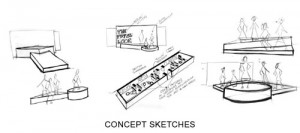 We also integrated into the plan a dark room to accommodate the fashion film “Basic Black”, a display of magazine spreads from the era, and a section devoted to the work of hair stylist Vidal Sassoon. These areas are located within sets of staggered walls reminiscent of a fashion runway backdrop. Rather than presenting all of the garments at once in a large expansive space, these small niches help to break up the gallery and make for a more dynamic experience as you proceed through the space.
We also integrated into the plan a dark room to accommodate the fashion film “Basic Black”, a display of magazine spreads from the era, and a section devoted to the work of hair stylist Vidal Sassoon. These areas are located within sets of staggered walls reminiscent of a fashion runway backdrop. Rather than presenting all of the garments at once in a large expansive space, these small niches help to break up the gallery and make for a more dynamic experience as you proceed through the space.
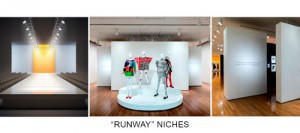
Once the final platform layout is set, we create fabrication drawings that explain the design and construction details to the carpenters. For this particular show, in order to accomodate the large-scale platforms, the carpenters built each platform in smaller sections and joined them on-site before applying a careful finish to make the seams disappear, a process that takes a lot of time and craftsmanship.

At this point in the process, the exhibition really starts to come alive. The walls are painted, the space cleared of debris, and the art installation begins. Our museum’s team of art handlers work with the curator to lay out the show and make final adjustments to the placements of mannequins and 2D artwork. Our team typically works diligently right up until the show opening when the patrons can finally experience the show.
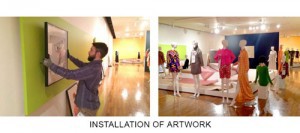 After this behind the scenes look at the exhibition design process for The Total Look, I hope that our faithful blog readers can appreciate the show from a new perspective the next time they visit the Cincinnati Art Museum. Countless amounts of details go into the planning, design, and execution of an art exhibition. While this article reveals only a small part of the challenges and logistical considerations our team encounters along the way, we enjoy what we do and love the satisfying feeling we get every time we see our visions come to reality—and we love that we can share that with our community.
After this behind the scenes look at the exhibition design process for The Total Look, I hope that our faithful blog readers can appreciate the show from a new perspective the next time they visit the Cincinnati Art Museum. Countless amounts of details go into the planning, design, and execution of an art exhibition. While this article reveals only a small part of the challenges and logistical considerations our team encounters along the way, we enjoy what we do and love the satisfying feeling we get every time we see our visions come to reality—and we love that we can share that with our community.
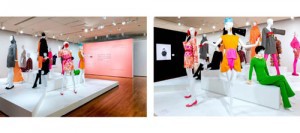
Cincinnati, OH 45202
Toll Free: 1 (877) 472-4226
Museum Hours
Museum Shop
Terrace Café
Library
The Cincinnati Art Museum is supported by the generosity of tens of thousands of contributors to the ArtsWave Community Campaign, the region's primary source for arts funding.

Free general admission to the Cincinnati Art Museum is made possible by a gift from the Rosenthal Family Foundation. Exhibition pricing may vary. Parking at the Cincinnati Art Museum is free.
Generous support for our extended Thursday hours is provided by Art Bridges Foundation’s Access for All program.

General operating support provided by:





